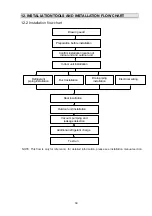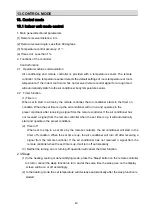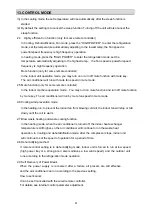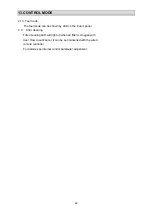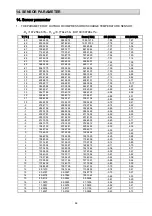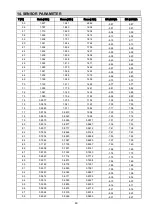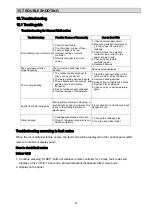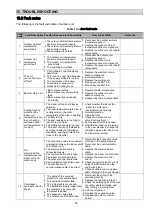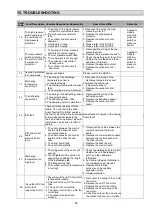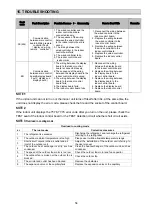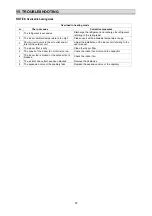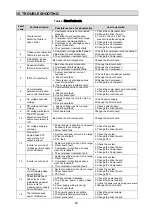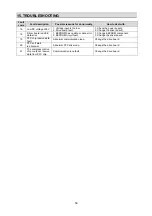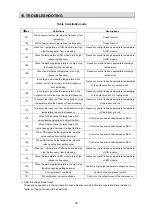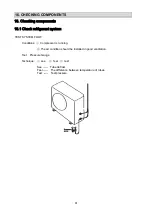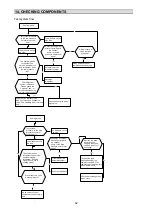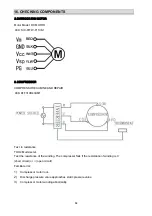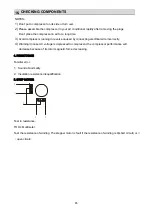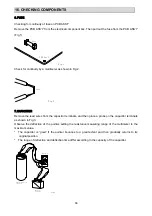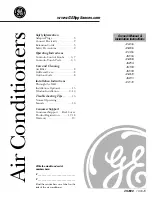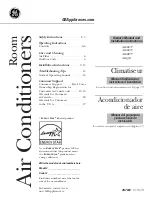
15.2 Fault codes
The following is the fault code table of outdoor
unit
.
Fault
code Fault Description Possible Reasons for Abnormality
How to Deal With
Remarks
1
Outdoor ambient
temperature
sensor fault
1. Reconnect the outdoor ambient
temperature sensor;
2. Replace the outdoor ambient
temperature sensor components;
3. Replace the outdoor control board
components.
2
Outdoor coil
temperature
sensor fault
1. The outdoor coil temperature
sensor is connected loosely;
2. The outdoor coil temperature
sensor fails;
3. The sampling circuit fails.
1. Reconnect the outdoor coil
temperature sensor;
2. Replace the outdoor coil
temperature sensor components;
3. Replace the outdoor control board
components.
3
The unit
over-current turn
off fault
1. Control board current sampling
circuit fails;
2. The current is over high because
of the supply voltage is too low;
3. The compressor is blocked;
4. Overload in cooling mode;
5. Overload in heating mode.
1. Replace the electrical control
board components;
2. Normal protection;
3. Replace the compressor;
4. Please see the NOTE 3;
5. Please see the NOTE 4.
4 EEprom Data error
1. Replace the EE components;
2. Replace the outdoor control
board components;
3. Reassembly the EE components.
5
Cooling freezing
protection(the
indoor coil
temperature is too
low) or heating
overload (indoor
coil temperature is
too high)
1. Check whether the indoor fan,
indoor fan motor and
evaporator work normally;
2. Normal protection;
3. Clean the filter;
4. Check the volume control
valve, duct length etc.;
5. Set the speed with high speed;
6. Reinstall the indoor unit referring
to the user manual to change the
distance between the indoor unit
and the wall or ceiling.
7
The
communication
fault between the
indoor unit and
outdoor unit
1. Reconnect the connection cable
referring to the wiring diagram;
2. Reconnect the communication
cable;
3. Replace the communication
cable;
4. Replace the indoor control board;
5. Replace the outdoor control
board;
6. Check the communication circuit,
adjust the DIP switch and the
short-circuit fuse;
7. Choose suitable communication
cable referring to the user manual.
13
Compressor
overheat protector
device
1. The wiring of the overload
protector is connected loosely.
2. The overload protector fails.
3. The refrigerant is not enough;
4. The installation pipe is longer than
the normal one, but no extra
refrigerant is added;
5. The expansion valve fails;
6. The outdoor control board fails.
1. Reconnect the wiring of the
overload protector;
2. Replace the overload protector;
3. Check the welding point of the unit
to confirm whether it leaks, and
then recharge the refrigerant;
4. Add the refrigerant;
5. Replace the expansion valve;
6. Replace the outdoor control
board.
1.The outdoor ambient temperature
sensor is connected loosely;
2.The outdoor ambient temperature
sensor fails to work;
3.The sampling circuit fails.
1.EE components fails;
2.EE components control circuit
fails;
3.EE components are inserted
incorrectly.
The indoor unit can not blow air
normally;
The room temperature is too low in
cooling mode or the room
temperature is too high in heating;
3.The filter is dirty;
4.The duct resistance is too high to
result in low air flow;
5.The setting fan speed is too low;
6.The indoor unit is not installed in
accordance with the installation
standards, and the air inlet is too
close to the air outlet .
1.
2.
1.The connection cable is connected
improperly between the indoor unit
and outdoor unit;
2.The communication cable is
connected loosely;
3.The communication cable fails;
4.The indoor control board fails;
5.The outdoor control board fails;
6.Communication circuit fuse open;
7.The specification of
communication cable is incorrect.
15.TROUBLESHOOTING
Table
1
Out
door fault code
53

